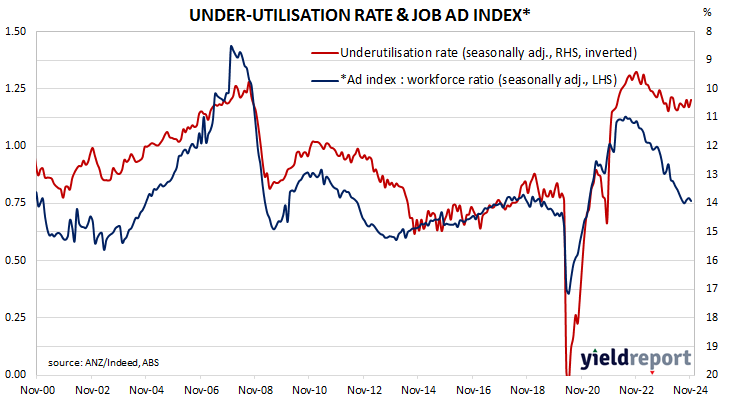Summary: Job ads down 1.3% in November; 11.5% lower than November 2023; ANZ: September, October advertising may have eaten into end-of-year-related hiring; short-term ACGB yields rise modestly, longer-terms yields steady; rate-cut expectations soften; Indeed: sharp fall in retail only partially offset by food services; ad index-to-workforce ratio slips.
From mid-2017 onwards, year-on-year growth rates in the total number of Australian job advertisements consistently exceeded 10%. That was until mid-2018 when the annual growth rate fell back markedly. 2019 was notable for its reduced employment advertising and this trend continued into the first quarter of 2020. Advertising then plunged in April and May of 2020 as pandemic restrictions took effect but recovered quite quickly, reaching historically-high levels in 2022.
According to the latest reading of the ANZ-Indeed Job Ads Index, total job advertisements in November decreased by 1.3% on a seasonally adjusted basis. Their index declined from 116.6 in October after revisions to 115.1, with the loss following rises of 2.3% and 0.7% in September and October respectively. On a 12-month basis, total job advertisements were 11.5% lower than in November 2023, up from October’s revised figure of -15.4%.
“It is possible some of the lift in September and October Job Ads reflected a pull-forward in end-of-year-related hiring,” said ANZ economist Madeline Dunk. “The coming months will determine whether the series resumes its previous downward trend.”
Short-term Australian Commonwealth Government bond yields rose modestly on the day while longer-term yields finished unchanged, ignoring the noticeable downward movement of US Treasury yields on Friday night. By the close of business, the 3-year ACGB yield had added 2bps to 3.93% while 10-year and 20-year yields both finished steady at 4.35% and 4.68% respectively.
Expectations regarding rate cuts in the next twelve months softened a touch. Cash futures contracts implied an average of 4.335% in December, 4.305% in February and 4.135% in May. November 2025 contracts implied 3.80%, 54bps less than the current cash rate.
“Christmas-related hiring continues to influence national trends, with a sharp fall in retail opportunities in November only partially offset by growing opportunities in food services ahead of the holidays,” said Indeed senior economist Callam Pickering. “Overall, Christmas-related hiring has provided more uplift to Job Ads this year than last year.”
The inverse relationship between job advertisements and the unemployment rate or the underemployment rate has been quite strong (see below chart), although ANZ themselves called the relationship between the series into question in early 2019.
A higher job advertisement index as a proportion of the labour force is suggestive of lower unemployment rates in the near future while a lower ratio suggests higher unemployment rates will follow. November’s ad index-to-workforce ratio slipped from 0.77 to 0.76.
In 2008/2009, advertisements plummeted and Australia’s unemployment rate jumped from 4% to nearly 6% over a period of 15 months. When a more dramatic fall in advertisements took place in April 2020, the unemployment rate responded much more quickly.



